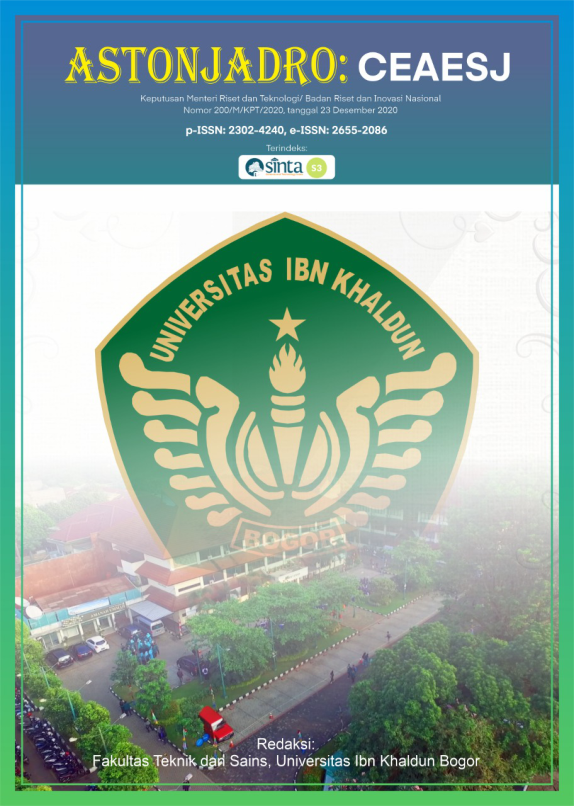LABOR PRODUCTIVITY RATING MODEL FOR LIGHT BRICK WALL INSTALLATION IN RESIDENTIAL PROJECTS
DOI:
https://doi.org/10.32832/astonjadro.v10i2.4998Keywords:
model, productivity rating, labor productivity, construction management.Abstract
Management on a construction project is something that cannot be ignored, because without construction management a project will be difficult to run according to expectations in the form of cost, time, quality and the success or failure of a construction project depends on the effectiveness of resource management. One way that can be done to achieve project objectives is to increase work productivity. This study aims to determine the productivity of labor in the installation of lightweight brick walls based on facts in housing projects. Labor productivity by analyzing the LUR value and productivity rating then becomes the regression analysis data to produce the model. The data search was carried out by direct observation to the field and conducting unstructured interviews with workers in the field. The resource persons are workers as artisans and workers who are experts in the work of installing light brick walls. This productivity measurement uses the productivity rating method, where worker activities are classified into 3 things, namely Essential contributory work, Effective work, and not useful. The results of the analysis show that the productivity of light brick wall installation workers based on the fact has higher productivity than the SNI labor coefficient. To calculate the labor productivity of installing lightweight brick walls, then the model from the results of this study can be used. The results of the evaluation of the model to predict labor productivity for installing lightweight brick walls have an average accuracy of 99.34%, so the model can be declared accurate.
References
Alsharef, A., Banerjee, S., Uddin, S. M., Albert, A., & Jaselskis, E. (2021). Early impacts of the COVID-19 pandemic on the United States construction industry. International journal of environmental research and public health, 18(4), 1559.
Huqban, A., Madkarsan, P. and Suhendi, C. (2020) ‘Analisis Keterlambatan Penyediaan Material Terhadap Ketepatan Waktu Pembangunan', Jurnal TESLINK : Teknik Sipil dan Lingkungan, 1(2), pp. 35–43. doi: 10.52005/teslink.v1i2.14. (Indonesian).
Jarkas, A. M., & Bitar, C. G. (2012). Factors affecting construction labor productivity in Kuwait. Journal of construction engineering and management, 138(7), 811-820.
Marguna, A., Hayati, N. I., & Rulhendri, R. (2020). APLIKASI TEKNIK EARNED VALUE DALAM PENGENDALIAN BIAYA DAN WAKTU PROYEK (Studi Kasus Proyek Pembangunan Gedung SDN Beji 2 Depok). ASTONJADRO: JURNAL REKAYASA SIPIL, 1(2), 44-56. (Indonesian). http://dx.doi.org/10.32832/astonjadro.v1i2.789
Marwahyudi, M. (2020). STIFFNESS DINDING BATU BATA MENINGKATKAN KEKUATAN STRUKTUR. ASTONJADRO: JURNAL REKAYASA SIPIL, 9(1), 30-37. (Indonesian). http://dx.doi.org/10.32832/astonjadro.v9i1.2840
Muslim, I., Z, Z. and Lubis, F. (2019) ‘Analisis Produktivitas Tenaga Kerja Pada Pekerjaan Dinding Facade (Studi Kasus Pada Proyek Pembangunan Hotel Pop Pekanbaru)', SIKLUS: Jurnal Teknik Sipil, 5(1), pp. 12–22. doi: 10.31849/siklus.v5i1.2388. (Indonesian).
Nabi, M. A., El-Adaway, I. H., & Dagli, C. (2020). A system dynamics model for construction safety behavior. Procedia Computer Science, 168, 249-256.
Nugroho, N. S. et al. (2020) ‘MODEL UNTUK MENENTUKAN JUMLAH TENAGA KERJA PADA', 1(2). (Indonesian).
Paikun et al. (2019) ‘Quick Ways to Calculate Shophouse Construction Project Materials Using Regression Analysis Program', 5th International Conference on Computing Engineering and Design, ICCED 2019, pp. 4–9. doi: 10.1109/ICCED46541.2019.9161083.
Paikun, Kadri, T. and Hudayani Sugara, R. D. (2018) ‘Estimated budget construction housing using linear regression model easy and fast solutions accurate', in 3rd International Conference on Computing, Engineering, and Design, ICCED 2017. doi: 10.1109/CED.2017.8308095.
Prayogo, A. (2017) ‘Pengukuran Efektifitas Dan Frekuensi Faktor Yang Mempengaruhi Produktivitas Pekerja Pada Pekerjaan Finishing Proyek Rumah Tinggal Di Surabaya', Dimensi Utama Teknik Sipil, 4(1), pp. 15–22. doi: 10.9744/duts.4.1.15-22. (Indonesian).
Rudi Waluyo; Subrata Aditama (2017) ‘PENGARUH RESOURCE LEVELING TERHADAP ALOKASI TENAGA KERJA PADA PROYEK KONSTRUKSI', 21(2), pp. 118–128. (Indonesian).
Sabariah, I., Syaiful, S., & Hayati, N. I. (2020). Analisis Metode Network Planning dan S-Curve Proyek Konstruksi di Bogor. ASTONJADRO: Jurnal Rekayasa SipiL, 1(1), 28-34. (Indonesian). http://ejournal.uika-bogor.ac.id/index.php/ASTONJADRO/article/view/782
Sigit, A. (2020). Analisis Koefisien Produktivitas Tenaga Kerja pada Pekerjaan Pasangan Bata (Studi Kasus Proyek Pembangunan Kost Eksklusif dan Villa Condongcatur). (Indonesian).
Siswadi, Y. (2017) ‘Pengaruh Pelatihan Dan Disiplin Terhadap Produktivitas Kerja Karyawan Padapt. Jasa Marga Cabang (Belmera) Medan', Jurnal Ilmiah Manajemen dan Bisnis, 17(01), pp. 124–137. (Indonesian).
Tannady, H. et al. (2019) ‘Analisis Produktivitas Operator Kasir Menggunakan Metode Work Sampling : Studi Kasus Gerai Chatime Mangga Besar', Jurnal Teknologi, 9(2), pp. 10–15. (Indonesian).
Thomas, H. R., Maloney, W. F., Horner, R. M. W., Smith, G. R., Handa, V. K., & Sanders, S. R. (1990). Modeling construction labor productivity. Journal of construction engineering and management, 116(4), 705-726.
Turner, C. J., Oyekan, J., Stergioulas, L., & Griffin, D. (2020). Utilizing industry 4.0 on the construction site: Challenges and opportunities. IEEE Transactions on Industrial Informatics, 17(2), 746-756.
Wulfram I. Ervianto (2008) Manajemen Proyek Kontruksi. (Indonesian).
Wong, J. H., Rashidi, A., & Arashpour, M. (2020). Evaluating the impact of building information modeling on the labor productivity of construction projects in Malaysia. Buildings, 10(4), 66.
Yulianty, C., Supriani, F., & Gunawan, A. (2021). ANALISIS PRODUKTIVITAS TENAGA KERJA PADA PEKERJAAN PASANGAN BATA PERUMAHAN TIPE 36 (Studi Kasus pada Perumahan Griya Putri Tanjung Kota Bengkulu). Inersia: Jurnal Teknik Sipil, 13(1), 8-16. (Indonesian).
Downloads
Published
How to Cite
Issue
Section
License
Paper submitted to ASTONJADRO is the sole property of the Astonjadro Journal. Unless the author withdraws the paper because he does not want to be published in this journal. The publication rights are in the journal Astonjadro.ASTONJADRO
LICENSE
This work is licensed under a Creative Commons Attribution-ShareAlike 4.0 International License.
Based on a work at http://ejournal.uika-bogor.ac.id/index.php/ASTONJADRO













